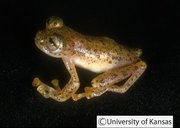|
Nymphargus anomalus (Lynch & Duellman, 1973)
Napo Cochran Frog, Anomalous Glassfrog, Rana de Cristal Anómala | family: Centrolenidae subfamily: Centroleninae genus: Nymphargus |
| Species Description: Cisneros-Heredia DF, McDiarmid RW 2007 Revision of the characters of Centrolenidae (Amphibia: Anura: Athesphatanura) with comments on its taxonomy and description of new taxa of glassfrogs. Zootaxa 1572:1-82. Described by Lynch and Duellman 1973 | |
 © 2010 Division of Herpetology, University of Kansas (1 of 2) |
|
|
|
Description Description: The male has a snout-vent length of 24.1 mm; Its head, with large protuberant eyes, is somewhat wider than the rest of its body width and is one-third of the snout-vent length. It has a truncate snout when seen from above and from the side. It has a round canthus and a concave loreal region. Its lips do not flare, and its nostrils are almost terminal on its snout. Located near the mouth margin, the choanae are small and egg-shaped. The tongue is not notched posteriorly. The vocal slits extend from the tongue base to the jaw angles. It lacks prevomerine teeth, has white bones, has a parietal peritoneum, and has a clear visceral peritoneum. The skin of the frog’s dorsum bears elevated warts and is dotted with spicules. On the ventral side, the belly and thighs are granular and the other areas are smooth. The supratympanic fold is weak, covering less than one-third of the tympanum. The lower two-thirds are visible and oriented posterolaterally with dorsal inclination. The hind legs are slender, and slightly over half the snout-vent length. The inner metatarsal tubercle is large and elongate in contrast with the outer metatarsal tubercle, which is small and round. The frog has webbing between outer fingers and on the feet, no webbing between the first and second fingers, and vestigial webbing between the second and third toes. Lateral fringes exist on the fingers. Finger and toe discs are round and truncate, larger on the fingers than on the toes, and subarticular tubercles are large and round. The first finger is longer than the second, whereas the fourth finger is nearly equal in length to the third (Lynch and Duellman 1973). Coloration: The individual collected was tan with black ocelli enclosing orange-tan centers. The ocelli are located on top of elevated warts. When preserved, dorsal coloring looks darker and ocelli centers are white. The ventral side is creamy tan (Lynch and Duellman 1973). Distribution and Habitat Country distribution from AmphibiaWeb's database: Ecuador
Trends and Threats Possible reasons for amphibian decline General habitat alteration and loss Comments The species is a member of the family Centrolenidae, the glass frogs. It has been placed in the genus Nymphargus based on morphological characteristics (Cisneros-Heredia and McDiarmid 2007). The species name “anomalus” comes from the Greek word, “anomalos,” meaning uneven or irregular because of the unusual tan color of N. anomalus (Lynch and Duellman 1973). N. anomalus is also known as Cochranella anomala (Coloma and Santiago 2004).
References
Cisneros-Heredia, D. F., and McDiarmid, R. W. (2007). ''Revision of the characters of Centrolenidae (Amphibia: Anura: Athesphatanura), with comments on its taxonomy and the description of new taxa of glassfrogs.'' Zootaxa, 1572, 1-82. Frost, D. (2011). Amphibian Species of the World: an Online Reference. Version 5.5. Lynch, J.D. and Duellman, W.E. (1973). ''A review of the centrolenid frogs of Ecuador, with descriptions of new species.'' Occasional Papers of the Musem of Natural History, University of Kansas, (16), 1-66. Stuart, S., Hoffmann, M., Chanson, J., Cox, N., Berridge, R., Ramani, P., Young, B. (eds) (2008). Threatened Amphibians of the World. Lynx Edicions, IUCN, and Conservation International, Barcelona, Spain; Gland, Switzerland; and Arlington, Virginia, USA. Originally submitted by: Emily McCloskey, Karin Dove, and Travis Winter (first posted 2011-04-21) Edited by: Mingna (Vicky) Zhuang (2012-03-22) Species Account Citation: AmphibiaWeb 2012 Nymphargus anomalus: Napo Cochran Frog <https://amphibiaweb.org/species/6961> University of California, Berkeley, CA, USA. Accessed May 30, 2025.
Feedback or comments about this page.
Citation: AmphibiaWeb. 2025. <https://amphibiaweb.org> University of California, Berkeley, CA, USA. Accessed 30 May 2025. AmphibiaWeb's policy on data use. |



 Map of Life
Map of Life